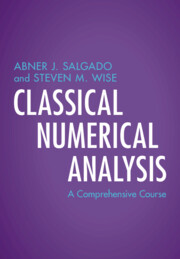Book contents
- Frontmatter
- Contents
- Preface
- Acknowledgements
- Symbols
- Part I Numerical Linear Algebra
- Part II Constructive Approximation Theory
- 9 Polynomial Interpolation
- 10 Minimax Polynomial Approximation
- 11 Polynomial Least Squares Approximation
- 12 Fourier Series
- 13 Trigonometric Interpolation and the Fast Fourier Transform
- 14 Numerical Quadrature
- Part III Nonlinear Equations and Optimization
- Part IV Initial Value Problems for Ordinary Differential Equations
- Part V Boundary and Initial Boundary Value Problems
- Appendix A Linear Algebra Review
- Appendix B Basic Analysis Review
- Appendix C Banach Fixed Point Theorem
- Appendix D A (Petting) Zoo of Function Spaces
- References
- Index
14 - Numerical Quadrature
from Part II - Constructive Approximation Theory
Published online by Cambridge University Press: 29 September 2022
- Frontmatter
- Contents
- Preface
- Acknowledgements
- Symbols
- Part I Numerical Linear Algebra
- Part II Constructive Approximation Theory
- 9 Polynomial Interpolation
- 10 Minimax Polynomial Approximation
- 11 Polynomial Least Squares Approximation
- 12 Fourier Series
- 13 Trigonometric Interpolation and the Fast Fourier Transform
- 14 Numerical Quadrature
- Part III Nonlinear Equations and Optimization
- Part IV Initial Value Problems for Ordinary Differential Equations
- Part V Boundary and Initial Boundary Value Problems
- Appendix A Linear Algebra Review
- Appendix B Basic Analysis Review
- Appendix C Banach Fixed Point Theorem
- Appendix D A (Petting) Zoo of Function Spaces
- References
- Index
Summary
We study the problem of approximating the value of a (weighted) integral of a function. We introduce the concepts of a quadrature rule and its consistency. Interpolatory quadrature rules and their construction are then discussed. Their error analysis, based on notions of previous chapters, is then presented. Then an error analysis based on the Peano Kernel Theorem and scaling arguments is developed. Newton-Cotes formulas then are developed and analyzed. Then, composite quadrature rules are presented and their use is illustrated. Their analysis is presented then, on the basis of Euler-Maclaurin formulas. The chapter concludes with a discussion of Gaussian quadrature formulas, their properties and optimality.
Keywords
- Type
- Chapter
- Information
- Classical Numerical AnalysisA Comprehensive Course, pp. 372 - 416Publisher: Cambridge University PressPrint publication year: 2022

